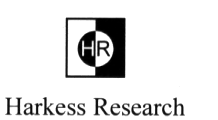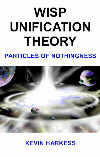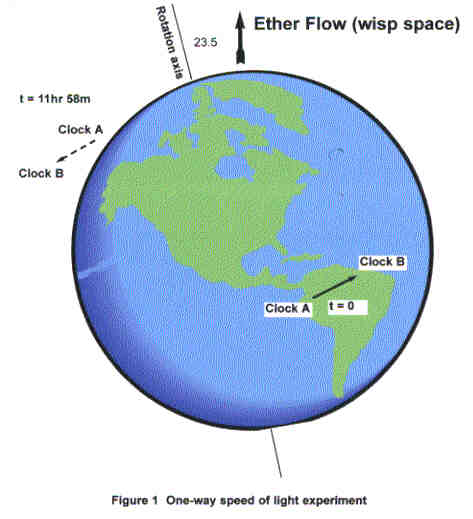
 Wisp
Unification Theory
Wisp
Unification Theory
Anisotropic one-way speed of light experiments
- Home
- About Me
- Reasons why Einstein was wrong
- One way speed of light experiments
- Hot topic
- Q&A
- ACES - The end of Relativity

- Book Contents
- Introduction
- 1 Matter,Space and Time
- 2 Symmetry
- 3 Fractals
- 4 Wisp Space
- 5 Gravity
- 6 Electromagnetic Force
- 7 Wisp & S.R: Fundamentals
- 8 Wisp & S.R: Electrodynamics
- 9 Wisp & S.R: Doppler effect
- 10 Wisp & S.R: Relativistic Mechanics
- 11 Big bang
- Appendix A
- Appendix B
- Index A-Z
- Copyright
- Feedback
Anisotropic one-way speed of light experiments
I propose three simple experiments that will prove that the one-way light speed (OWLS) is anisotropic, which will lead us to conclude that experiments on Earth that measure the speed of light two-ways are flawed. These one-way experiments have not been done because relativity assumes the one-way speed of light is constant and fixes it so through convention, and so no attempts are made to measure it.
Wisp theory predicts that simple one-way speed of light experiments falsify Einstein's claim that the speed of light is constant for all inertial observers.
A claim supported by George Smoot, Wrinkles in Time, 1993 - “Any clear sign of a variation in c, the speed of light, as the Earth [revolved] would prove that the aether existed.”
Anisotropic one-way speed of light experiment using two clocks and a laser
This experiment has never been done.
Let V be the speed at which the Earth moves through the ether, say 360 km/s. Two clocks A and B are placed on any East - West line 10 km apart. A laser continuously fires light pulses from clock A to clock B as the Earth rotates. After several days, the laser light's travel time measurements are compared and time differences between measurements are determined. The maximum difference values will be found to vary with a frequency that is the sidereal period.
Earth's rotation provides a mechanism that allows light to travel with (vb) and against (va) the ether flow without altering the setup, whilst ensuring that light travels one-way only - from clock A to clock B - at all times.
A key benefit of this experiment is that the two clocks used do not initially have to be synchronized, which removes any argument over which synchronization method to use. Measurements must first be obtained to establish zero-crossing points in the time difference values, and since light travels from clock A to clock B all cases, these count as a series of separate one-way measurements. As the Earth rotates, measurement differences will vary in a sinusoidal manner, revealing maximum and minimum values. Figure 1 shows the setup.

Using values of ether flow from Miller and DeWitte's data, the maximum time difference can be calculated using wisp theory, see equation set for one-way experiment. Time errors due to clock synchronization automatically cancel out.

Next, we synchronize the clocks at a zero-crossing point using Einstein's method. We take the centre line between our maximum and minimum as our zero reference. Then, wait until the Earth's rotation places the clocks a point where measurements in time differences cross the zero reference line, and synchronize the clocks.
Now the clocks are correctly synchronized, the speed of light one-way is simply 10000/(Clock B-Clock A). And the result will be affected by the ether flow.
Later, the experiment should be repeated with the clocks placed on any North - South line. And by comparing both sets of results the direction of ether flow can be determined to a greater accuracy.
Many tests have shown that the two-way speed of light is isotropic. However, the proposed experiment will correctly test the isotropy of the one-way speed of light, and will show special relativity to be false.
With advances in atomic clock technology, soon clocks 1000 times more accurate will be placed on satellites orbiting the Earth, and they will reveal a sidereal variation in their timekeeping when compared to Earth-based clocks. Relativity will have no explanation for the variation; only an ether-based theory can provide the answer.
Absolute one-way speed of light experiment
This experiment has never been done.
A similar device using a line of known length to separate the clocks is tested in free space. It rotates slowly in a plane parallel to the ether flow. When the clocks align perpendicular to the ether flow, the speed of light is reduced by gamma, but because the clocks run slow by gamma, they record the speed at which light travels as being its true absolute speed. So, once the clocks have been synchronized at a zero-crossing point, to calculate the absolute speed of light, c, simply divide twice the distance (2L) by the sum of the perpendicular travel times, t1 (clock B - clock A), and t2 (clock B - clock A, 180 degrees later).
Note: In free space the effects of jiggle dilation are negligible, and so it would be possible to measure the absolute speed of light using one clock and a mirror. When they align perpendicular to the ether flow, the average two-way light speed would be its absolute speed, c.
Similar anisotropic one-way speed of light experiment using two clocks A and B
This experiment has never been done, and is very simple.
It is independent of clock synchronization method and if the result is positive it will prove special relativity false.
Setup: Two identical atomic clocks A and B are required.
Atomic clock A sends a microwave sync pulse to clock B, which is L=30km
away. When B receives the first sync pulse it sets its time to 0. Every
minute, clock A logs the time and sends out a sync pulse to clock B, which
logs the time when it receives it.
If special relativity (SR) is right - that the speed of light stays constant
- the results would show clock times A-B=0.
See table 1. The time for the sync pulse to travel from A to B is T, which
according to SR stay constant at 0.0001 seconds (the time is unimportant
as long as it says constant throughout).
|
Clock A time (s)
|
Clock B time (s)
|
A-B time difference
|
|
0.0000000000
|
0.0000000000
|
0.0000000000
|
|
60.0000000000
|
60.0000000000
|
0.0000000000
|
|
120.0000000000
|
120.0000000000
|
0.0000000000
|
|
180.0000000000
|
180.0000000000
|
0.0000000000
|
Table 1
If SR is wrong and the ether affects the speed of light, T would not be constant, but would vary as T= L/(c+/-V), and the results would show A-B is not zero. See table 2. The reason being, as the earth rotates, the sync pulse's relative speed c+/-V would be affected by the ether wind.
|
Clock A time (s)
|
Clock B time (s)
|
A-B time difference
|
|
0.0000000000
|
0.0000000000
|
0.0000000000
|
|
60.0000000000
|
60.0000000000 + delta t1
|
- delta t1
|
|
120.0000000000
|
120.0000000000 + delta t2
|
- delta t2
|
|
180.0000000000
|
180.0000000000 + delta t3
|
- delta t3
|
Table 2
For an ether wind of 360km/s the plot of delta t values will show up as a sidereal variation, with a peak-peak value ranging from 96nS to 240nS, dependent on the angle the sync pulse makes with the equator. This experiment is independent of clock synchronization method and a sidereal variation in the delta t plot will prove SR false.
Anisotropic one-way speed of light experiment that have been done
Recent one-way experiments favour anistoropy in the speed of light:
1) In August 2006 C E Navia et al report on a search for anisotropic
light propagation as a function of laser alignment relative to the Earth's
velocity vector. A laser diffraction experiment was conducted to study
light propagation in air. The experiment is easy to reproduce and it is
based on simple optical principles. Two optical sensors (segmented photo-diodes)
are used for measuring the position of diffracted light spots with a precision
better than 0.1 µm. The goal is to look for signals of anisotropic light
propagation as function of the laser beam alignment to the Earth's motion
(solar barycenter motion) obtained by COBE. Two raster search techniques
have been used. First, a fixed laser beam in the laboratory frame that
scans due to Earth's rotation. Second, an active rotation of the laser
beam on a turntable system. The results obtained with both methods show
that the course of the light rays are affected by the motion of the Earth,
and a predominant quantity of first order with a dc/c = -(betta)(1+2a)
cos(theta) signature with a = -0.4106±0.0225 describes well the experimental
results. This result differs in a amount of 18% from the Special Relativity
Theory prediction and that supplies the value of a = -1/2 (isotropy).
See
http://xxx.lanl.gov/abs/astro-ph/0608223
2) In April 2006 Carlos. E. Navia and Carlos. R. A. Augusto report results
on an "one-way light path" laser diffraction experiment as a function
of the laser beam alignment relative to the Earth's velocity vector obtained
by COBE measurements of the Doppler shift in the cosmic microwave background
radiation (CMBR). An amplified Doppler shift is observed in the diffraction
images, and the effect is compatible with a "dipole" speed of light anisotropy
due to Earth's motion relative to the "CMBR rest frame", with an amplitude
of dc/c = 0.00123. This amplitude coincides with the value of the dipole
temperature anisotropy dT/T = 0.00123 of the CMBR obtained by COBE. Our
results point out that it is not possible to neglect the preferred frame
imposed by the cosmology and they are well described by the Ether Gauge
Theory (an extension of the Lorentz's ether theory) and it satisfies the
cosmological time boundary condition. See
http://arxiv.org/PS_cache/astro-ph/pdf/0604/0604145v1.pdf
3) In 1991 Roland DeWitte carried out a one-way experiment using electrical
signals rather than light. His results confirm wisp theory's prediction
that the speed of light is affected by the ether flow passing the Earth.
(See Reasons why Einstein was wrong for further details).
4) In 1990 T. P. Krisher et al carried out a one-way experiment
by sending modulated laser light down a fibre optics (fiber optics) cable.
However, because of experimental noise the result was inconclusive, and
the duration of the test was perhaps too short to detect the sidereal
period variation, and could not rule out an ether flow that is at rest
with respect to the CMBR.